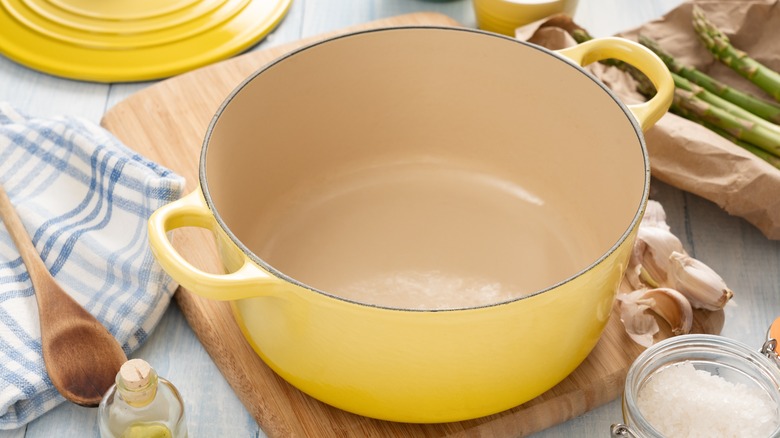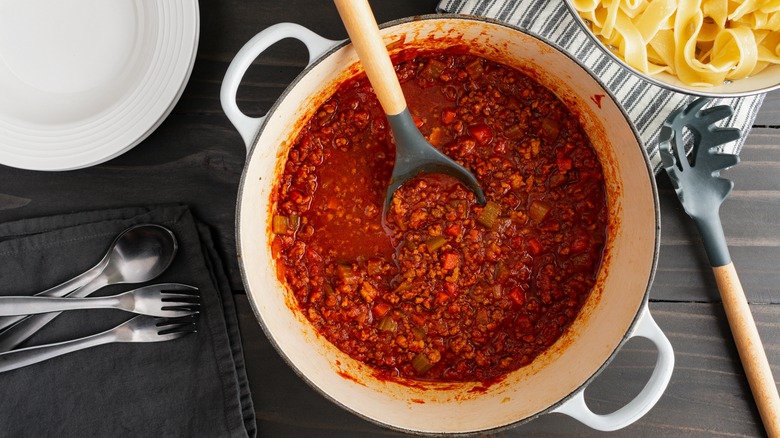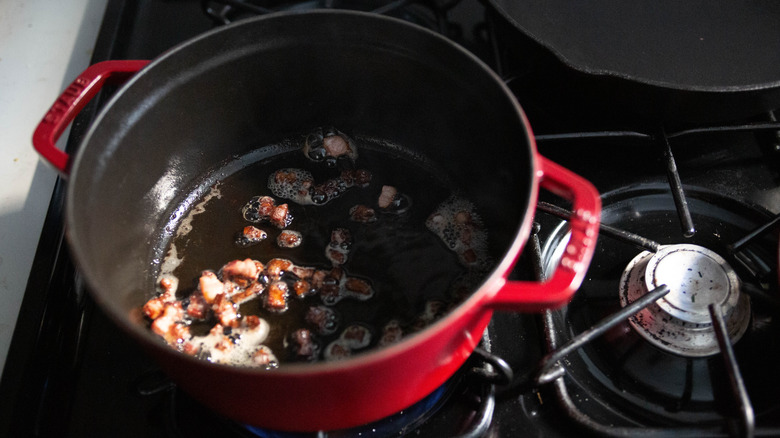What Is A Dutch Oven And Do You Really Need One?
In the wide world of cookware, the Dutch oven receives a lot of questions that few people would dream of asking about skillets or saucepans. "What on earth is it?" and "Is it worth purchasing?" are two of the most common queries. The first answer is fairly simple: A Dutch oven is a casserole dish with high, thick walls and a tight-fitting lid. It's traditionally made from seasoned cast iron, but modern incarnations can also be ceramic, aluminum, or enameled. The enameled style is technically a version of the Dutch oven known as a French oven, but you can just call it an enameled Dutch oven. Still with us? Good.
The Dutch oven possesses a number of features that make it perfect for a wide range of cooking methods, including braising, stewing, searing, and even baking. But do you actually need one if you're already performing all these culinary activities with other pieces of cookware? If you love slow-cooked meals, enjoy baking bread, or want a versatile kitchen workhorse, a Dutch oven just might be a worthwhile investment.
History and key features of Dutch ovens
There's clearly something good about the Dutch oven's design. It's been in use since its invention in the 1600s, when the Dutch came up with a superior method for casting metals in sand molds. The Netherlands at that time was producing top-quality copper and brass pots — not exactly the cheapest materials. So in the early 1700s, an Englishman applied their pot-making process to the more cost-effective cast iron, keeping the name Dutch oven.
That means today's bare cast iron Dutch ovens are pretty much the same stalwart vessel used not only in the 1700s but also in the American colonies and on the Lewis and Clark expedition. They're nearly indestructible — this is cookware with heirloom potential — and they're great at getting hot and staying hot. They're heavy, though, weighing roughly 11 to 20 pounds depending on capacity. Cast iron Dutch ovens also need to be treated and seasoned like any cast iron pan, so no soaking, no dishwasher, no steel wool, and be careful when cooking acidic foods like tomatoes: Metallic flavors can transfer to the food, and the pan's seasoning can be impacted.
Aside from weight, enameled cast iron Dutch ovens are a different story. Caring for them is almost a no-brainer — even cleaning a Dutch oven with burnt food stains is fairly straightforward. There are also no issues with cooking acidic foods in them, so go ahead and make your tomato sauce recipe in your pretty, shiny enameled Dutch oven. They're comparable to ceramic Dutch ovens, the other common material, in their versatility, but ceramic is much lighter — and much less durable. Drop it, and it's probably done.
Who needs a Dutch oven, and who doesn't
The type of cooking you usually do is a major factor in whether you need a Dutch oven. If you're fond of slow cooking, enjoying braises, stews, and chilis, you could benefit from the Dutch oven's ability to maintain low, even heat over long periods. On the other hand, its heavy base can get blazing hot, perfect for searing meats before braising or creating a flavorful fond. Dutch ovens can also go directly from the stovetop into the oven, making them perfect for cleanup-minimal one-pot meals. Finally, with the Dutch oven's heavy, steam-trapping lid, it expertly manages everything from crusty breads to pizzas to cobblers.
Though the Dutch oven is the cookware equivalent of the ever-utilitarian Swiss Army knife, your habits and lifestyle may not require one. If you tend to stick to cooking methods like steaming, grilling, or pan-frying, a Dutch oven could be overkill. And considering the dish's weight and bulk, it may not be the pot for you if you're low on storage space or aren't able to lift heavy objects. But if you don't recognize yourself in this paragraph and have been at all piqued by the one above it, a Dutch oven would be a worthwhile investment in your culinary arsenal.


